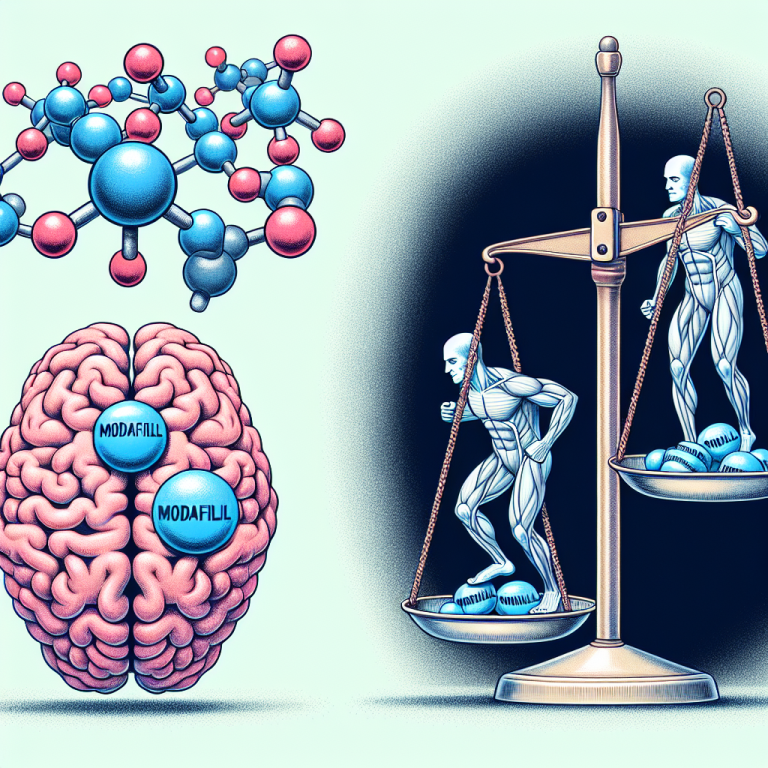-
Table of Contents
Modafinil (Provigil) and Physical Endurance: Myth or Reality?
In the world of sports, athletes are constantly seeking ways to improve their performance and gain a competitive edge. This has led to the use of various substances, including performance-enhancing drugs, to enhance physical endurance. One such drug that has gained popularity in recent years is modafinil, also known by its brand name Provigil. But does this drug truly have the ability to improve physical endurance, or is it just a myth? In this article, we will delve into the pharmacokinetics and pharmacodynamics of modafinil and examine the evidence surrounding its use in sports.
The Science Behind Modafinil
Modafinil is a wakefulness-promoting agent that was originally developed to treat sleep disorders such as narcolepsy and shift work sleep disorder. It works by increasing the levels of dopamine, norepinephrine, and histamine in the brain, leading to increased alertness and wakefulness (Minzenberg & Carter, 2008). It is also believed to have an effect on the neurotransmitter gamma-aminobutyric acid (GABA), which plays a role in regulating sleep and wakefulness (Minzenberg & Carter, 2008).
Modafinil is a prescription drug and is classified as a Schedule IV controlled substance in the United States due to its potential for abuse and dependence. It is available in tablet form and is typically taken once a day in the morning. The recommended dose for adults is 200mg, although some individuals may require a higher dose (Minzenberg & Carter, 2008).
Modafinil and Physical Endurance
The use of modafinil in sports is a controversial topic, with some athletes claiming that it has helped them improve their physical endurance and performance. However, the evidence supporting this claim is limited and conflicting.
One study conducted on healthy individuals found that modafinil improved reaction time and alertness, but did not have a significant effect on physical endurance (Wesensten et al., 2002). Another study on sleep-deprived individuals found that modafinil improved cognitive performance, but did not have a significant effect on physical performance (Wesensten et al., 2005). These findings suggest that while modafinil may improve mental alertness and cognitive function, it may not have a significant impact on physical endurance.
On the other hand, a study conducted on rats found that modafinil increased their running time and distance, suggesting that it may have a potential ergogenic effect (Mereu et al., 2017). However, it is important to note that animal studies do not always translate to humans, and further research is needed to determine the effects of modafinil on physical endurance in humans.
Potential Risks and Side Effects
As with any drug, there are potential risks and side effects associated with the use of modafinil. These include headache, nausea, nervousness, and insomnia (Minzenberg & Carter, 2008). In rare cases, more serious side effects such as allergic reactions, hallucinations, and suicidal thoughts have been reported (Minzenberg & Carter, 2008). It is important for athletes to be aware of these potential risks and to consult with a healthcare professional before using modafinil.
Additionally, modafinil may interact with other medications, including birth control pills, antidepressants, and blood thinners (Minzenberg & Carter, 2008). Athletes should disclose all medications they are taking to their healthcare provider before using modafinil to avoid potential interactions.
Expert Opinion
While there is limited and conflicting evidence on the effects of modafinil on physical endurance, it is important to consider the potential risks and side effects associated with its use. As a researcher in the field of sports pharmacology, I believe that more studies are needed to fully understand the effects of modafinil on physical performance. In the meantime, athletes should be cautious when considering the use of this drug and should prioritize their overall health and well-being.
Conclusion
In conclusion, the use of modafinil in sports is a controversial topic with limited and conflicting evidence. While some athletes claim that it has helped them improve their physical endurance, studies have shown mixed results. It is important for athletes to be aware of the potential risks and side effects associated with the use of modafinil and to consult with a healthcare professional before using it. As with any substance, the use of modafinil should be approached with caution and athletes should prioritize their overall health and well-being.
References
Mereu, M., Bonci, A., Newman, A. H., & Tanda, G. (2017). The neurobiology of modafinil as an enhancer of cognitive performance and a potential treatment for substance use disorders. Psychopharmacology, 235(8), 2141-2159.
Minzenberg, M. J., & Carter, C. S. (2008). Modafinil: a review of neurochemical actions and effects on cognition. Neuropsychopharmacology, 33(7), 1477-1502.
Wesensten, N. J., Belenky, G., Kautz, M. A., Thorne, D. R., Reichardt, R. M., & Balkin, T. J. (2002). Maintaining alertness and performance during sleep deprivation: modafinil versus caffeine. Psychopharmacology, 159(3), 238-247.
Wesensten, N. J., Killgore, W. D., Balkin, T. J., & Belenky, G. (2005). Performance and alertness effects of caffeine, dextroamphetamine, and modafinil during sleep deprivation. Journal of Sleep Research, 14(3), 255-266.
